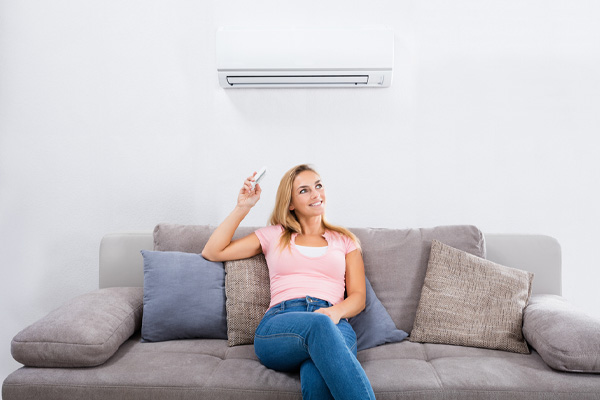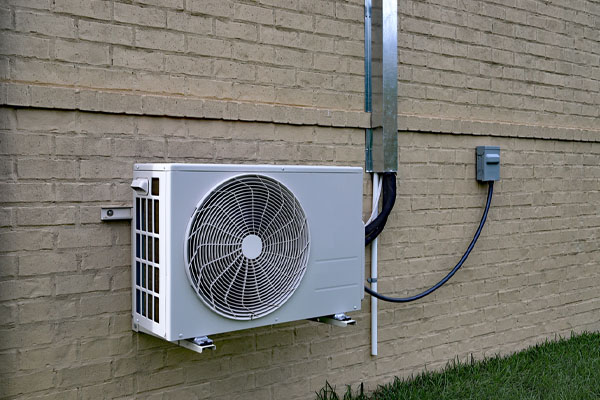How Do Ductless Air Conditioners Work?

Ductless air conditioners, as their name implies, are air conditioners that have no ducts. In principle, they work the same as central air conditioners. They both cool your home by sucking in warm air, absorbing the moisture and heat from the air, and dumping it outside.
However, because these air conditioners lack HVAC ductwork, these units can only deliver cold air in a targeted area. But with central air conditioners, the cold air channels into a system of air ducts that can be distributed throughout your home.
Although this description can be pretty self-explanatory, many homeowners still ask the common question, “How do ductless air conditioners work?”
How Do Ductless Air Conditioners Work?
Contents
Let us answer this question by checking out the components of the ductless air conditioner and the difference between a single-zone mini-split and multi-zone ductless HVAC setups.
Components of A Ductless AC Unit

Ductless air conditioners consist of three main components. These are the following:
- Evaporator or Blower Unit: The evaporator or the blower unit is part of the ductless air conditioner that is located indoors. These components are thin and about 3 inches in length. Their function is to pull in the warm air in the room. They do this by absorbing moisture and heat from the air and then channeling it back to the room. In other words, the blower unit directs cold air into the room while also sending heat and moisture outside. But to do this, they would need the help of another component, the conduit.
- Conduit: A conduit connects the indoor component with the outside component of the AC. This is a thin and long cable where you’ll also find the refrigerant tubing, condensation drain, and power cable. The conduit is the one that provides electrical power to the indoor and outdoor parts of the ductless air conditioner unit. And at the same time, it serves as a corridor through which the moisture and heat from the inside of your home pass to the exit point, which is the condenser.
- Condenser: The condenser is the last component of our ductless AC unit. We can also refer to it as the outside component, which functions to take all the heat from your house and unload it outside.
Single-Zone Mini-Split Vs Multi-Zone Ductless Set-Ups
Because ductless air conditioners are usually designed to deliver cold air only in one target area, would they also be effective in multi-room applications? Well, good news! Ductless air conditioners can be used effectively in single rooms and multi-zone spaces.
You can install ductless air conditioner units in various settings by using one of these two set-ups:
The Single-Zone Mini-Split
As the name implies, the single-zone mini-split contains a single evaporator and outdoor condenser, making it ideal for cooling a single room or zone.
However, if you have enough outdoor space, you can set up a multi-zone ductless HVAC system. With this, you can still set up numerous ductless air conditioners that will work simultaneously and cool your entire building.
What’s great about this system is that you can customize the temperature control in each zone. And on top of that, even if one system malfunctions, none of your other systems would be affected.
The Multi-Zone Ductless HVAC
Next, we have the multi-zone ductless air conditioning system.
This system relies on a single outdoor condenser that’s connected to multiple indoor evaporator or blower units. With this set-up, each one of the indoor units comes with a thermostat wherein you can control each unit independently, depending on which room needs cooling.
This configuration is very cost-effective and is ideal for homes and buildings where different rooms require various cooling needs.
Which Ductless Air Conditioning Set-Up is For You?
Suppose you want a more customizable system that allows for proper zoning. In that case, you can opt for a multi-zone mini-split system that comes with a separate compressor circuit linked with each evaporator or blower unit. The best part about this is that occupants of each zone can customize the temperature control settings based on their needs.
Do Ductless Air Conditioners Have Adequate Cooling Power?
Individual indoor units look small mainly because they’re meant to cool a single zone or room. But this is great because it makes cooling your home a lot easier.
However, if you want your unit to function at its optimum, you need to match BTU capacity with the size of the room. Generally, the bigger the room size, the higher the BTU rating you’d need. And obviously, this is not something that you can simply guess.
To effectively determine the cooling load, you’d need the help of an HVAC contractor as they’ll be using various factors to determine what’s best for you.
If you get a system that is too small, the system will have no choice but to overwork to cool the room. This may lead to rapid wear and tear and frequent HVAC repairs. On the other hand, getting a system that is too large will lead to short cycling. This means that the system will turn on and off frequently, which can shorten the unit’s lifespan. Furthermore, an oversized system will not be able to remove humidity adequately or improve indoor air quality as effectively as one that is properly sized.
As a guide, here are the standard unit sizes that you’d need to get depending on the room measurement:
- Rooms measuring around 400 to 650 square feet will need a unit that provides 12,000 BTUs per hour.
- A room measuring around 600 to 1000 square feet will need a unit that provides 18,000 BTUs per hour.
- Rooms measuring around 800 to 13,000 square feet will need a unit that provides 24,000 BTUs per hour.
These are just standards, but if you wish to get the exact measurement that fits you, you need to call a licensed HVAC contractor to learn more about ductless air conditioning systems.
Pros and Cons Of Ductless Air Conditioners
 Now, let us discuss some pros and cons of ductless air conditioners units.
Now, let us discuss some pros and cons of ductless air conditioners units.
Ductless AC Pros
- Ductless air conditioners come with built-in zoning. This allows occupants of each room to customize the temperature settings independently.
- Ductless air conditioners are energy-efficient. According to Energystar.gov, duct leakage often leads to 20-30 percent of wasted conditioned air. But with ductless air conditioners, you no longer have to worry about leakages.
- Ductless air conditioner units are ideal and less costly, especially for homes with no pre-installed ductwork. Many older homes don’t have the space needed for the installation of additional or new ductworks. On top of that, installing ductwork also often involves cutting through walls, floors, and ceilings, which can be a hassle and costs a lot.
- Ductless air conditioners are very versatile as they can be mounted on floors, walls, ceilings, depending on the configuration of your home.
Cons Of Ductless Cooling Systems
- Ductless air conditioners cost more upfront. However, even if this is the case, these systems are more customizable and more energy efficient. The cost of the associated ductwork can significantly increase the upfront cost of a central AC system, making the system more expensive than a ductless system of the same size.
- Ductless air conditioners are difficult to hide. While central ACs can be hidden in the basement, attic, or closet, ductless ACs, on the other hand, would only have to be mounted on walls, floors, or ceilings. However, they are also less intrusive and sleeker compared to window AC units.
Conclusion
Ductless air conditioners are customizable, versatile, and energy-efficient. They also eliminate the need for an air distribution duct, making them generally cheaper to install and maintain than central air conditioners.
Call Lawes Company For All Of Your HVAC Requirements

Lawes Company offers superior heating and cooling services in Monmouth and Ocean County, New Jersey.
We make sure to hire certified technicians who can provide you with excellent services, including HVAC tune-ups, repairs, installations, and replacements. Each technician has outstanding knowledge and experience to serve your HVAC system needs correctly.
Lawes Company guarantees to provide the most competitive heating and cooling service costs in the area. Our maintenance services ensure to improve your comfort, increase your system’s energy efficiency, and reduce your home’s heating and cooling costs.
Need your system repaired or replaced? We’ll recommend the best one for your home and is within your budget. The best part is, we back all our work with a guarantee to ensure your satisfaction.
If you wish to schedule a service appointment, give us a call today! We also offer free in-home estimates.
Contact us now at (732) 741-6300 to find out more!